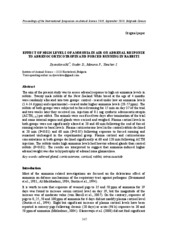Effect of High Levels of Ammonia in Air on Adrenal Response to Adrenocorticotropin and Forced Running in Rabbits
| dc.contributor.author | Dyavolova, M | |
| dc.contributor.author | Gudev, D | |
| dc.contributor.author | Moneva, P | |
| dc.contributor.author | Yanchev, I | |
| dc.date.accessioned | 2015-09-19T13:50:00Z | |
| dc.date.available | 2015-09-19T13:50:00Z | |
| dc.identifier.uri | http://arhiva.nara.ac.rs/handle/123456789/683 | |
| dc.description.abstract | The aim of the present study was to assess adrenal response to high air ammonia levels in rabbits. Twenty male rabbits of the New Zealand White breed at the age of 4 months were randomly allocated into two groups: control - reared under low air ammonia levels (1.4-14.6 ppm) and experimental – reared under higher ammonia levels (28-57 ppm). The rabbits of both groups were subjected to forced running for 15 min on day 37 of the trial and two weeks later they received i.m. injection of 0.1 mg synthetic adrenocorticotropin (ACTH1-24) per rabbit. The animals were sacrificed two days after termination of the trial and some internal organs and glands were excised and weighed. Plasma cortisol levels in both groups were not significantly altered at 20 and 60 min following the end of forced running relative to basal levels. Plasma corticosterone level in the control rabbits declined at 20 min (P<0.01) and 60 min (P<0.05) following exposure to forced running and remained unchanged in the experimental group. Plasma cortisol and corticosterone concentrations in both groups declined significantly at 60 and 120 min following ACTH injection. The rabbits under high ammonia levels had heavier adrenal glands than control rabbits (P<0.01). The results are interpreted to suggest that ammonia-induced higher adrenal weight was due to hypertrophy of adrenal zona glomerulosa. | en |
| dc.subject | adrenal gland | en |
| dc.subject | corticosterone | en |
| dc.subject | cortisol | en |
| dc.subject | rabbit | en |
| dc.subject | tetracosactide | sr |
| dc.title | Effect of High Levels of Ammonia in Air on Adrenal Response to Adrenocorticotropin and Forced Running in Rabbits | en |
Files in this item
This item appears in the following Collection(s)
-
International Symposium on Animal Science 2014, 23-25th September 2014, Belgrade, Serbia, www.livestocksym.com
University of Belgrade, Faculty of Agriculture, Institute for Zootehnics



